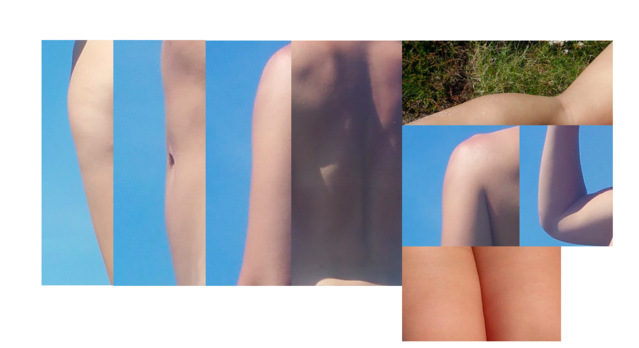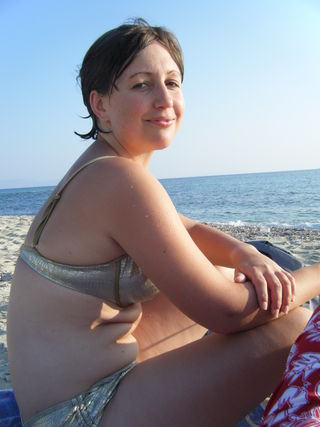Beauty
Is Thin Beautiful? Looking and Seeing
Observing yourself observing others, and yourself.
Posted August 3, 2017
(This post is the sequel to this one, which disentangled some of the reasons why it's easy to think of thinness as in itself beautiful.)
Delving into the details
Take a moment, when you next see a picture of someone thin (Thin or Thin 2.0 [i.e., 'toned']), to observe what happens. What holds your eye to the long indent between the upper abdominals, or the gentlest of curves around the navel, or the emptiness between the inner thighs? It feels like there’s no delay between the visual impression and the appraisal, like however hard you tried you could never catch the perception and neutrally, calmly experience it before the judgement leapt in: beautiful, not beautiful, how does that compare to me, why aren’t I like that, how do I get more like that, what would be better about my life if I were like that… With practice, though, the ties can be loosened. Quite quickly, in fact, I find that if I pay concerted attention to a single image, it’s a bit like staring at a word, or saying it over and over, until it seems strange and surreal and not like a word at all. Try it with the word THIN. Try it with a thin model. In time the line turns back into being just a line. It’s neither beautiful nor not beautiful; it just is. Those judgements once so hasty to scramble over each other to reach the percept can’t quite get there any more.
This gives us a different approach to that classic spectre of the anorexic aesthetic: the straight line. The sweep of the uncluttered cheekbone, the hard edge of the sinewy arm, the severity of the fatless thigh. Is there beauty in these things? More than in the straightness there is in, say, a strong quadriceps cloaked in an optimal layer of fat; more than in the smooth curve of the dimpled elbow?
Here they are, released from their surroundings: fragments of me, ill, recovering, and well. Is one more beautiful than the other, or are they simply variations on reality? What kind of reality?



Looking at these isolated segments has the interesting side-effect of making me realise how much straighter many of lines actually are in health than in sickness. If one cares about straight lines, which there’s no particular reason to, starvation is probably not how best to get them.
Alternating between a sustained focus on the line in isolation and the context it’s embedded in can be an interesting practice. Find some picture of someone thin (whichever of the two variants tends to bother or entice you more).
Look at one of its lines until the line loses meaning.
Then look at the skin which borders it.
Then work your way to the adjoining limb.
Then to the face.
Then to the pose of the body as a whole.
Then to the background immediately surrounding the body.
Then the wider background.
Keep that slow, neutral stance. What place does that first line have now in this slice of world? Is the tree half occluded by the body just as beautiful?
Playing thus with the anorexic tendency to zoom in on a single body part—first taking it to the extreme that subverts it, then refusing it with the gradually encompassing gaze—has an interesting power, for me at least.
I’m not suggesting that all the compulsions and the insecurities fall away with such a simple practice—but they begin to. And every moment of freedom makes another more likely. I remember an afternoon a few years ago when someone linked on Facebook to an Olympic relay success from someone at my old school. It’s hard to recreate now, the confused feverish pain I felt gazing at her fatless muscled body, especially the outlines of her abs, and (with perfect awareness of the extent of the contradiction) knowing none of it should cause me any pain. But there was a longing, a reaching-out for the absolute nonsuperfluousness of every inch of her that was hard, while it lasted, to resist. But there is no more inherent superfluity in fat than in muscle (you can have too much and too little of either), and there was no more superfluity in my body than hers.
It’s possible, and often helpful, to proceed on to other kinds of cognitive defusing.
Ask yourself what it would cost you to look like that, and what it’s probably cost them.
Ask what would really be better about your life if you did.
Ask which of the many influencing factors are involved in making it likely you’ll feel just like this right now: from your mood to the photo angle and post-production.
These are all valuable skills to develop, but there’s a power too in the practice of simply looking. Don’t let yourself skip to the next image that confirms the last and your imperfection; just sit with this one, attentive, expectant, daring it to do its worst.
And in the spirit of letting things do their worst, I wonder whether turning things around and thinking about our reactions to not-thinness might be a good place to start. (I’m repeatedly aware as I write that we have no single word for not-thin: we have the clumsy options of ‘normal weight’ and ‘healthy weight’, with all their extra connotations, but there is no neat English adjective for ‘just right’.)
The bigger picture

Here’s a picture of me. It’s not a picture I was ever happy with, but it is a picture of me blissfully happy. I was a year past the end of weight gain after anorexia. My partner and I were staying on the Greek island of Naxos. I was in love and I was as healthy as I could conceivably have been at that point in my life: I was letting recovery take its course, in all senses. Here it is: the dreaded disproportionate restoration of abdominal fat after malnutrition (El Ghoch et al., 2014). I didn’t know to expect that, and in general I was interested enough in everything else that was changing to set aside photos like this, or glimpses in the mirror that showed me things like this, and turn back to what mattered more.
Look at me here, as I am looking now, as I write. Feel what happens when your eyes turn from my face, where maybe they start, to my tummy, where inevitably they will settle a while. Feel how natural, even in me, is the near-instant auto-correct: the pulling in, the smoothing off, the flattening out. We do it to ourselves, we do it to others, we do it to ourselves because others do it to themselves, and to others because others do it to us. The same with the faint frown lines on my brow, and the tired sagging of my eyelids: I can imagine them all away. And all have indeed faded with time, not through any magic crayon but through the real magic of living life well and patiently and self-caringly.
I do not think I look physically beautiful in this photo. But there is beauty in it, and in me as depicted in it, because of the slightly imperious ease in my posture, the sleepy if gently questioning trust in the photographer, the willingness to be there, sitting, captured but not captive, looking at him more than feeling myself looked at, letting him see me not trying to arrange myself for him. There is love there, and it makes me happy to see it, even as I observe the ‘flaws’, and observe myself observing them.
It’s easy as anything to find fault with this body, and it’s also easy to marvel at this body, for where it had been, and was going. Can the same be true of bodies other than our own, bodies about we have so much more limited backstories? Can we find it in us to find the compassion that seeks things in images that are not the relative simplicities of form and colour, but the greater complexities of character and history?
It may seem that there’s a profound difference. I may, without really reflecting on it, vaguely intuit that it costs me nothing to look at someone who is beautiful in many respects but also unhealthily thin, and to admire them for their beauty and for the thinness which may or may not enhance it. Whereas looking at myself, I might know I have a duty to myself to appreciate my body in health and to reject the values which foster illness and which may in some people’s eyes enhance my beauty but for which I would pay a price.
But if we take this thought seriously, we realise there is no difference. It does cost me something to admire beauty at the price of health and happiness in anyone, including myself; I lose something every time I revel in another’s suffering, because in so doing I contribute one more jigsaw piece to a society that revels thus.
We can’t change everything about how we respond to things, but we can decide not to credit our responses. What does that mean? Before anything else, it means simply observing. Observe the observation. Observe with no other intention than to observe. Already in so doing you will weaken the attachment between you and the observation.
Next, not crediting our responses means not treating them as obviously inevitable. It means taking the time, once we have simply sat with them a while, to explore where they come from and where they can lead: exposing them systematically to challenge (as in the list of defusing questions above). It means refusing, when we can, to act on them, whether it’s by complimenting our body-obsessed friend on something other than their figure, or not doctoring our own photos. And as we practise all these little ways of not treating the easy responses as the stopping place, maybe we’ll notice one day that they’ve stopped rising up in us quite as inevitably as they used to. Maybe we’ll realise we have a broader eye to those things which speak of more than appearance.
Find a photo of yourself, or find yourself in the mirror, and let fat do its worst. Feel the self-judgement, the longing for colder, hungrier lines. Then ask yourself what the worst is that it could do. Asking myself that now, I see that the worst it could do would be to blind me to everything else I am in this photograph: healing, full of hope, full of love, bathed in the pre-prandial sea sunset. I sought out this photo because I remembered an old vague feeling of dissatisfaction with it. But I come away from it warmed by memories of that holiday, and glowing appreciation of the years that have led from it to me. So thank you, tummy fat.
It’s so terribly easy to forget it, or let it be drowned out by the clamour of this age of surfaces – but beauty is not merely visual. Or rather, the visual takes in more than the merely material. We should give ourselves more credit for seeing beauty beyond the outlines of a body-as-object. A body is not a carved bowl: it talks back. When not immobilised in photographs or scripted in videos, we have thoughts, we have undercurrents, we have a thousand contradictions, we generate emotions and convictions and echo and alter them. The beauty we perceive that has meaning, and staying power, is not in the millionth sculpted abdomen, it is in the hands that come to us when we fall, the long meeting of eyes where breath ceases, the powerful gestures accompanying the passionate demolition of dogma, the shared pace of the one who walks by our side, the standing in the face of the storm and refusing to be cowed. And beyond the visible, it’s in the depths of a voice speaking with calm command, in the hug that has sincerity, in the smell of sweat from work shared. Beauty is in all these sensory phenomena, and in all of them it points beyond. All of them are in the body, require the body, but require it as subject not object.
The aesthetic should elevate us, not diminish us. Whether through pleasure or through learning, it should leave us more than we were before, not less. Any image that belittles us is not beauty. We mistake it for beauty, and mistakenly credit our aspiration to it, whenever it makes us turn ourselves into objects.
So can there be anything beautiful about starving yourself, to extremes or less ostentatiously? Maybe, if it’s in a cause greater than self-objectification or some other form of fear. But it rarely is.
References
El Ghoch, M., Milanese, C., Calugi, S., Lamburghini, S., and Grave, R.D. (2014). Anorexia nervosa and body fat distribution: A systematic review. Nutrients, 6, 3895-3912. Full text here.




